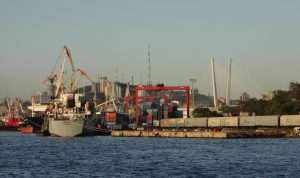 The container throughput of Russian ports dropped by 0.7% in the first 9 months of 2016 as compared to the same period of 2015, according to the data published by the Association of Russian sea ports. In January-September, 2016 Russian ports handled 2.94 mln TEU, which can be considered stabilization after a drastic drop of 26% last year. The 9 months volume in 2014 was 3.99 mln TEU.
The container throughput of Russian ports dropped by 0.7% in the first 9 months of 2016 as compared to the same period of 2015, according to the data published by the Association of Russian sea ports. In January-September, 2016 Russian ports handled 2.94 mln TEU, which can be considered stabilization after a drastic drop of 26% last year. The 9 months volume in 2014 was 3.99 mln TEU.
As we noted earlier in the analysis of 8 months’ throughput, the major reason for the decline was import cargo, which dropped by 30% last year due to the economic sanctions declared by the Russian government, the devaluated ruble and weakening of consumer demand. In 2016 import volumes have stabilized. Thus, during the first 9 months of the year 1.2 mln TEU were handled, same as in 2015, but 30% less than in 2014 (1.75 mln TEU).
At the same time the loaded export volumes are increasing, mainly due to a stable growth in exported containerized cargo, such as metal and wood industry products, chemicals, mineral fertilizers. Thus, year 2014 showed a 20% jump in loaded export volumes, in 2015 the growth was just about 1% and this year 785.5 th. TEU were handled, which is 12.6% more than last year.
Both growing export and weak import account for the drastic decrease of empty export volumes handled by Russian ports: 430 th. TEU in January-September, 2016 (-21% to 2015 and -59% to 2014).
Russian cabotage volumes slightly grow year on year, mostly due to coastal shipments to northern territories in the Far East and Arctic. In the 9 months of 2016 Russian ports handled 458.6 th. TEU of cabotage (+6.9% to 2015 and +7,9% to 2014).
Russian ports are primarily ports of destination or origin, transit volumes are quite low here and mostly handled by the Far Eastern ports. However, the current crisis makes them even lower: only 34.9 th. TEU were handled in January-September, 2016 (-37.6% to 2015 and -53% to 2014).
Analyzing the throughput of particular ports, we note the gradual recovery at the Baltic ports after a shocking 30,8% downfall last year, from 2.14 mln TEU in 9 months of 2014 to 1.48 mln TEU in 2015. This year the ports handled 1.5 mln TEU (+1.4% to 2015). The little growth was recorded mostly due to loaded export volumes (+11.1%) and import volumes (+3.5%). In the analyzed period of 2016 the port of St.Petersburg, where major Russian container stevedores operate, handled 1.3 mln TEU (+0.7% to 2015). However the new port of Ust-Luga is still struggling: only 61.8 th. TEU (-5.7% to 2015), after a 19% decline last year.
The container ports of the Black Sea also show signs of improvement after last year’s drop of 18%, although the TEU figures are much lower than in the Baltics. In January-September of 2016 the ports handled 466.8 th. TEU (+1.7% to 2015), with its flagman port of Novorossiysk handling 455.8 th. TEU (+2.9% to 2015).
The worst situation is observed at the ports of Russian Far East. After a collapse of 23% last year, their throughput is still decreasing: 859 th. TEU (-5.9% to 2015), the main reasons being the import volumes that cannot overcome the 36.8% downfall last year (234.9 th. TEU in 9 months of 2016, -8.6% to 2015), empty exports (110.5 th. TEU, -26.3% to 2015) and falling transit figures (34.7 th. TEU, -37.7% to 2015). The port of Vladivostok shows better results (453.9 th. TEU, -1.9% to 2015) than its main rival, the once largest and best equipped port of Vostochny (220.4 th. TEU, -19.2% to 2015).
It is worth noting that the Arctic ports (Murmansk, Arkhangelsk, Dudinka) handled 107.9 th. TEU, which is +10,4% to their results in 9 months of last year. These ports mostly handle cabotage volumes (100.4 th. TEU).
